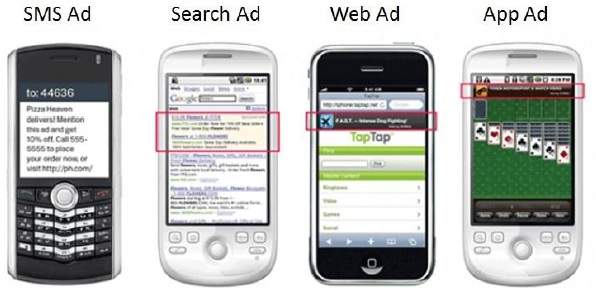
- Online Marketing Home
- Online Marketing Introduction
- Online Marketing Terminology
- SEO Friendly Website
- Online Advertising
- Mobile Advertising
- Search Engine Marketing
- E-Mail Marketing
- Affiliate Marketing
- Social Media Marketing
- Online Reputation Marketing
- Content Marketing
- Blogs, Banners & Forums
- Web Analytics
- Online Marketing Efforts
- Impact, Pros & Cons
- Celebrity Online Marketers
Mobile Advertising
Smartphones are reinventing the connection between companies and their customers.
− Rich Miner, Partner at Google Ventures and Co-Founder, Android
Use of web-enabled smartphones in last decade has increased exponentially. The people use mobile devices to communicate with their family, friends, colleagues, and acquaintances. They stay connected to the society on various social networks, keep themselves updated on current affairs and lifestyle. Apart from accessing E-Mails, browsing, and messaging, people spend a huge amount of time on mobile apps for their utility and entertainment quotient.
Today, the mobile devices such as smartphones, e-books, and tablets are inseparable parts of their daily lives. Mobile advertising takes the advantage of this thereby reaching out to the hands, pockets, and bags of the people.

What is Mobile Advertising?
It is a form of business promotion on Internet-enabled mobile devices such as smartphones, e-books, and tablets to deliver marketing Advertises.
Objectives of Mobile Advertising
Increasing the brand awareness.
Promoting business with good Ads across all mobile phone models, network technologies, and data bandwidths.
Providing support for specific engagements.
Driving sales of the product or service.
Advantages of Mobile Advertising
Mobile advertising comes with the following advantages −
Mobile advertising provides an opportunity to connect with the people on-the-go and at a personal level.
It helps to achieve your objective of winning new customers and earning conversions.
It helps to fulfill your business branding goals.
It can deliver intended impact by posting engaging and interactive Ads on the mobile Internet and Apps.

Mobile Advertising Units
The Mobile Advertising can be done in the following ways −
Mobile Web Banner Ad
It is a universal colored graphics Ad unit displayed on a Mobile website. It is a still image or an animation intended for use in mass-market campaigns. It must be allowed to click by the viewers and can be placed in any location on a mobile-friendly website.
The recommended formats for these Ads are − GIF, PNG, or JPEG formats for still images and GIF format for animated images.
Rich Media Mobile (RMMA) Ad
It is a supplement Ad unit defined by the two-stages − display and activation. In display, an RMMA Ad resides in a usual Ad space of an application or website and calls for action in form of a banner or similar Ad unit. The RMMA features are activated only when the viewer clicks or swipes on the displayed banner.
WAP 1.0 Banner Ad
It is a supplement monochrome, still graphics Ad unit for Ads that target older mobile phones which do not support graphics. It can be followed by a Text Tagline Ad to emphasize the clickable character in the Ad unit.
Text Tagline Ad
It is an Ad unit that displays only text. Text links may be used below a Mobile Web Banner Ad. It also can be used for older mobile phones which do not provide support for graphics. At times the publishers also prefer to use them over graphical ads on mobile websites. Mobile screen width has no effect on text tagline sizes.
Text Messaging (SMS) Ad
The Short Message Service (SMS) allows communication between mobile phones by exchanging short text messages limited to 160 characters. Short Messages can be exchanged among all operating networks on every mobile phone in the world. Thus it creates a vast market for SMS-based advertising.
SMS supports messages exchanged among mobile users as well as among mobile users and machines, such as a PC, application, or server.
It is a text-only medium. The font size is entirely controlled by the mobile phone and is not under the control of advertiser or publisher.
Length of Ad lies between 20 to 90 characters.
Ad is inserted by publisher only at the end of the SMS content.
Multimedia Messaging Service (MMS) Ad
The advertising opportunity using MMS is significant. MMS is a rich media messaging service that allows mobile users to exchange the messages or media with images, audio, video, and text. MMS Ads can be of various types such as Short Text Ads, Audio Ads, Video Ads, Banner Ads, etc.
This media resides on the users mobile phone once received, hence Wi-Fi or data connection is not required to access the Ad content again.
The MMS image Ads come in JPEG and PNG formats for still images and in GIF format for animated ones. They come in varied sizes such as Small, Medium, Large, extra Large, double extra Large.
The recommended video formats are 3GP and 3G2.
They must not exceed 100KB file size.
Mobile Video Ad
These Ads are played as video on the mobile. The advertisers need to follow the recommendation for Mobile Video content as given −
Landscape aspect Ratios should be 4:3, 16:9, and 11:9.
File formats should be − WMV, AVI, MOV, MPEG2, .3GP
Audio quality should be − 16bit 44Khz stereo.
Video quality should be − 250kbps, 20-30 frames per second.
Avoid using fast-moving videos.
Avoid rapid scene changes.
Avoid using small font for advertising messages.
Avoid dark shots.
Mobile App Ads
These Ads are launched by the publishers alongside the host mobile application. To minimize users frustration about loading the App, publishers should display these Ads before launching or after exiting of the application. It is recommended that −
Mobile users are notified that they will be leaving App environment to experience the Ad.
If Ads need to be displayed during the use of App, they publishers should use banners to avoid switching the user away from the application domain.
Publishers need to prevent the users right to cancel the Ad and return to the App.
Sensor-Enabled Mobile Advertising
The problem with the conventional Ads such as banners was they were designed for personal computers. They are translated to mobile version with a great effort. They are so small that the mobile users prone to click on them unintentionally and regret for doing so. Also, with the conventional mobile Ads, the users have to click through to another website where they find the product and proceed for purchasing.
Experts are developing sensor-based motion Ads to enhance users experience with the mobile Ads.
Using Mobile Sensors for Advertising
Most state-of-the-art smartphones have a number of tiny sensors. There is an accelerometer to detect movement and orientation of the mobile phone, the gyroscope for measuring device rotation around X, Y, and Z axes, a compass to detect North direction, etc. Together, these sensors are extremely useful for mobile advertising.
For example, an Ad can be created for making your own cocktail which requires shaking the phone after selecting a few ingredients. Thus, it would be very engaging and interactive in a realistic manner.
Creating such Ads require machine learning algorithms that can understand different motions and take action on them. A challenge with these Ads is, they need to respond to the users action in real time.
